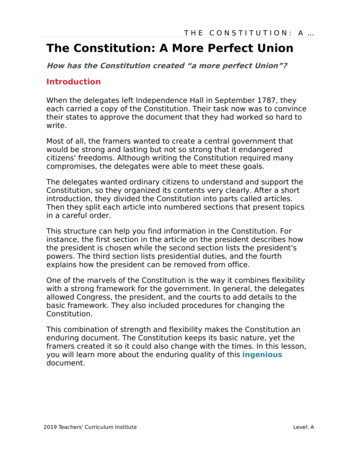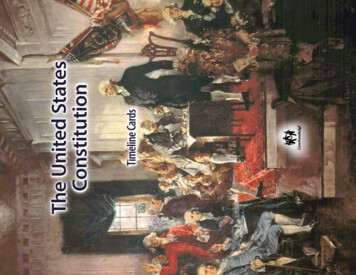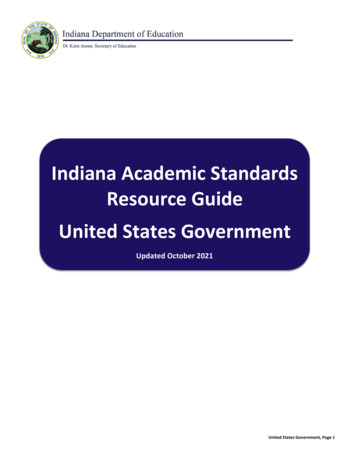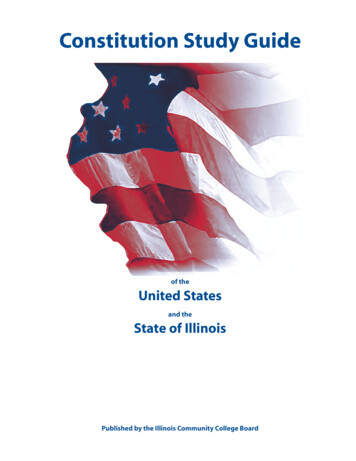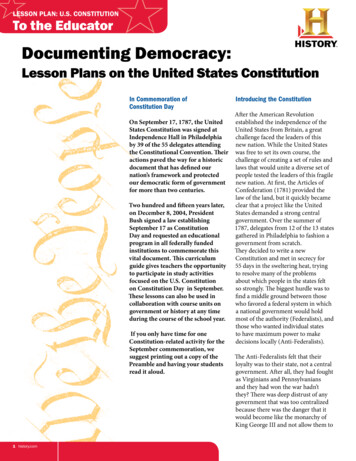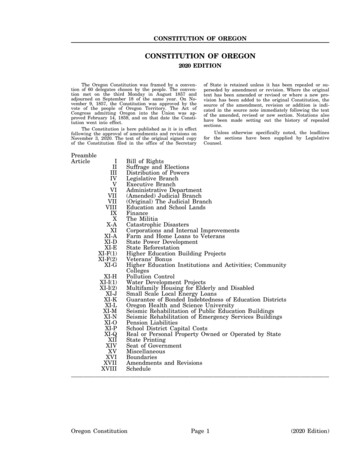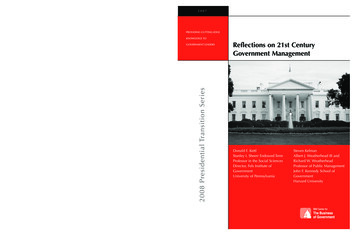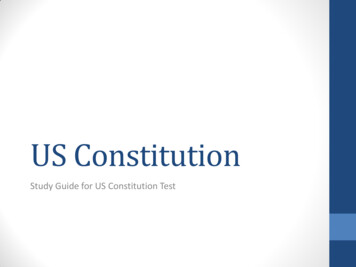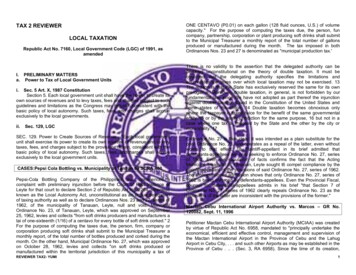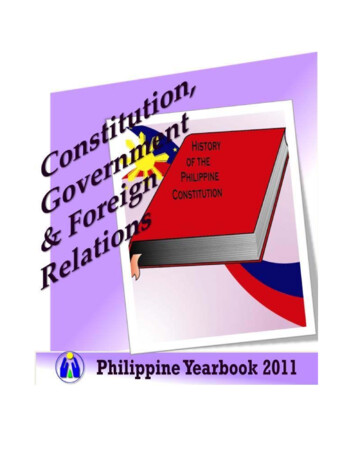
Transcription
3Constitution, Government,and Foreign RelationsIntroductionThe Constitution is the fundamental law of the land which defines and protectsthe country’s ideals, identity, and independence. It prescribes the framework of thegovernment and embodies the principles, maxims, and fixed rules in accordance withwhich the powers of sovereignty should be exercised.The country follows a democratic system of government and its constitutionprovides a clear picture of how the three branches of the government the executive,the legislative, and the judiciary exercise their powers. While laying down thefundamentals of government, the Philippine Constitution also mandates the state topursue an independent foreign policy. With the Department of Foreign Affairs (DFA) atthe helm, the Philippine government has continued to create and implement programsaimed at improving its bilateral relations with other countries.3.1 History of the Philippine ConstitutionThe Philippine Constitution underwent several changes over the pastcentury. Constitutional revisions have altered the functions of the government and areseemingly affecting the discernment of the country’s future.The 1935 Constitution. During the American occupation, two organic acts of theUS Congress – the Philippine Bill of 1902 and the Philippine Act of 1916 also knownas the Jones Law – served as the bases of governance. However, the two laws werefound inadequate to steer a commonwealth government the US had desired for thePhilippines. Hence, the 1935 Constitution was chartered, enabling the Philippines tobe ready for self-governance and achieve full independence from the US in 1945.With a new republic overlaid after the Commonwealth period, the 1935Constitution still held its ground as the country's supreme law, even decades later.The 1973 Constitution. When Republic Act 6132 better known as the 1971Constitutional Convention Act was passed, a new constitution was imminent. Some300 delegates from all over the country convened on June 1, 1971 and begandesigning a new constitution. The draft was approved on November 29, 1972, about18 months after the inaugural session and two months after the imposition of MartialLaw. By January 17, 1973, the Constitution was in full force following Proclamation1102.The 1973 Constitution ensconced a modified parliamentary form ofgovernment that was thought to be more conducive to the country's progress at that
CONSTITUTION, GOVERNMENT, AND FOREIGN RELATIONStime. A close relationship between the executive and legislative bodies was thenperceived as the solution to iron out constant deadlocks in passing urgent laws, whichultimately led to delays in government operations. Power in this form of governmentrested on an elite few—the President, his right-hand who was the Prime Minister, andthe Cabinet. They worked hand-in-hand with the Legislative House, known as theBatasang Pambansa. The 1973 Constitution lasted for 12 years until the ouster ofPresident Marcos in 1986.The 1987 Constitution. After the most celebrated "EDSA People Power," asweeping change in government put to power a new Chief Executive, Corazon C.Aquino. She immediately promulgated the Freedom Constitution by issuingProclamation No. 3 on February 25, 1986, the same day she assumed office. The newconstitution set in motion a reorganized government.After establishing a provisional government, President Aquino assigneddelegates who would frame the new constitution. The draft was finished in 133 daysafter the delegates' appointment, and was later ratified on February 2, 1987. The newConstitution, restoring democracy, offers Filipinos social freedom and economicjustice, national sovereignty, and participatory democracy.The Constitutional FrameworkAs with other constitutions, the 1987 Charter starts with a preamble orintroductory statement on the intent of the law and definition of the government’sobjectives. The articles contained in the Constitution can be summarized briefly, asfollows:Article I - The National Territory. It identifies the boundaries and territoriesbelonging legally to the country including the terrestrial, fluvial, and aerial domain. Theterritorial sea, the seabed, and other submarine areas are likewise defined.Article II - Declaration of Principles and State Policies. This states that thePhilippines is a democratic and republican state and that Philippine sovereigntyresides in the people. It also states that the Church and State are separate entitiesand neither one can encroach on the other’s domain.Article III - Bill of Rights. This is the summary of the fundamental rights of thepeople against violation of the state. No person may be deprived of life, liberty, orproperty without due process of law. One important provision of this article is the rightto bail, which should not be impaired even when the privilege of the writ of habeascorpus is suspended.Article IV - Citizenship. This defines those who are Filipino citizens at the time ofthe adoption of the Constitution. It also describes how lost citizenship may bereacquired.
NSO 2010 Philippine YearbookArticle V - Suffrage. All citizens of the Philippines have the right to vote and bevoted upon to public office, and no substantive requirement may be imposed in theexercise of it.Article VI - The Legislative Department. Legislative power is vested in theCongress of the Philippines, which consists of the Senate and the House ofRepresentatives. The Senate is made up of 24 members while the House ofRepresentatives is composed of not more than 250 members, unless otherwise fixedby law. It also states the qualifications, remuneration, and terms of office of allsenators and representatives.Article VII - The Executive Department.This stipulates the duties andresponsibilities of the President and the Vice-President. The executive power isvested in the President. The Vice-President has the same qualifications and elected inthe same manner as the President. The President, however, is not eligible forreelection, while the Vice-President may serve two consecutive terms.Article VIII - The Judicial Department. Judicial power is vested in one SupremeCourt and in such lower courts as may be established by law. The Supreme Court iscomposed of the Chief Justice and 14 associate justices. The President appoints alljustices and judges of the lower courts.Article IX - Constitutional Commissions. This names the three constitutionalcommissions that enjoy fiscal autonomy: the Commission on Elections, theCommission on Audit, and the Civil Service Commission. The President, with theconsent of the Commission on Appointments, appoints the chairman of eachcommission and the additional commissioners.Article X - Local Government. In the general provisions, this article describesthe territorial and political subdivisions of the Republic, which are provinces, cities,municipalities, and barangays. The political subdivisions enjoy local autonomy. Theyare entitled to an equitable share in the proceeds of national wealth within theirrespective areas. The autonomous regions include the Cordilleras and MuslimMindanao. These regions have their own organic acts that define the basic structureand functions of their local units.Article XI - Accountability of Public Officials. Public office is a public trust,hence, public officers and employees must at all times be accountable to serve thepeople with utmost responsibility, integrity, loyalty, and efficiency. The President, VicePresident, members of the Supreme Court, members of the ConstitutionalCommissions, and the Ombudsman may be removed from office by impeachment. Allother public officers and employees may be removed from office through legal meansand not by impeachment.Article XII - National Economy and Patrimony. The goals of the nationaleconomy are a more equitable distribution of opportunities, income, and wealth; asustained increase in goods and services produced by the nation; and an expanding
CONSTITUTION, GOVERNMENT, AND FOREIGN RELATIONSproductivity. These goals are considered key to raising the quality of life for all. In thepursuit of these goals, all sectors of the economy should be given the opportunity todevelop.Article XIII - Social Justice and Human Rights. The highest priorities in thelegislative process involve the enactment of laws to protect and enhance the rights ofall people that will redound to human dignity and reduction of social, economic, andpolitical inequalities, diffused wealth and political power for the common good. TheState shall ensure full protection of laborers—local and overseas—and promote fullemployment and employment opportunities for all. There shall be an agrarian reformprogram founded on the rights of farmers and farm workers to own the lands they tilland to receive just share of the fruits of their toil.A continuing program of urban land reform shall provide decent housing andbasic services to the underprivileged and homeless citizens in urban areas. Anintegrated approach to development shall be designed to make essential goods andservices available to all people at affordable cost. The State shall protect workingwomen by providing safe and healthful conditions and facilities that will enhance theirwelfare and enable them to realize their full potential in the service of the nation. TheState shall also respect the role of non-government and people’s organizations and bydoing so, enable these organizations to pursue their legitimate interests andaspirations through peaceful and lawful means.This article also embodies the provision to establish the Commission onHuman Rights, which shall be headed by a Chairperson over four othercommissioners.Article XIV - Education, Science and Technology, Arts, Culture, andSports. A primary goal of the State is to maintain and support a complete andadequate system of education relevant to the needs of the people and of society ingeneral. Free public education is compulsory in the elementary and secondary levels.The national language shall be Filipino and shall be further developed and enrichedon the basis of existing Philippine languages and dialects. Priority shall be given toresearch and development and to science and technology, education, lots of training,and services. The State shall foster the preservation, enrichment, and dynamicevolution of a Filipino national culture based on the principle of unity in diversity, in aclimate of free artistic and intellectual expression. The State shall promote physicaleducation and encourage sports programs, including training for internationalcompetitions to foster self-discipline, teamwork, and excellence for the development ofa healthy and alert citizenry.Article XV - The Family. This recognizes the family as the foundation of thenation. The State shall, therefore, strengthen its solidarity and shall actively promoteits total development.Article XVI - General Provisions. Among others, these provisions state that thePhilippines shall have a flag of three colors: red, white, and blue, with a sun and threestars, and will be consecrated and honored by the people. The Armed Forces are theprotectors of the people and the country. All members of the Armed Forces shouldtake an oath of allegiance to uphold and defend the Constitution.
NSO 2010 Philippine YearbookArticle XVII - Amendments or Revisions. Any amendment or revision to theConstitution may be prepared by Congress or by constitutional convention.3.2 The National GovernmentPursuant to the provisions of the 1987 Constitution, the Philippines revertedto the presidential form of government. In this setup, three departments — theexecutive, the legislative, and the judiciary — coordinate to ensure the smooth flow ofgovernmental affairs.The Executive DepartmentThe President acts as the executive official, assisted by the Vice-Presidentwho is a member of the Cabinet, and the Department secretaries. The President andVice-President are elected by direct vote for a term of six years. The President is noteligible for reelection but the Vice-President may serve for two consecutive terms.With the concurrence of the Commission on Appointments, the President isvested with the power to nominate and choose the Cabinet members, ambassadorsand other public posts. As the Commander-in-Chief of the Armed Forces, thePresident can call on the military to prevent or suppress violence, invasion, orrebellion. He also can suspend the privilege of the writ of habeas corpus, or place thecountry or any part of it under martial law, when public safety requires it and aswarranted by the Constitution.The President may also grant amnesty with the concurrence of a majority ofall members of the Congress. He may contract or guarantee foreign loans on behalf ofthe Philippine Republic with prior concurrence of the Monetary Board and subject tothe limitations as may be provided for by law.The Legislative DepartmentLegislative power pertains to the exercise of enacting laws and legislationconsistent with the country’s ideals, aspirations, and the passing of bills andresolutions to be enacted into law, including the General Appropriations Bill. Alsoincluded in the legislative power are the conduct of inquiries in aid of legislation andthe resolution of all contests relating to election returns and qualifications of Housemembers.Legislative power is vested in the Congress, which is a bicameral bodyconsisting of the Senate (the Upper House) and the House of Representatives (theLower House). Congress convenes once a year but the President may call at any timea special joint session of both houses. On the fourth Monday of July of every year, thetwo Houses of Congress convene to signify the start of another year of lawmaking.This opening of Congress is marked by the Philippine President’s State of the NationAddress (SONA).There are powers reserved for the sole exercise of Congress. It alone hasthe power to declare a state of war in the country. It also gives the President authorityto exercise powers necessary and proper to carry out declared national policy.
CONSTITUTION, GOVERNMENT, AND FOREIGN RELATIONSCongress is presided over by two main officers, namely, the President of theSenate and the Speaker of the House of Representatives. Both the Senate Presidentand the House Speaker are elected by a majority vote of all the members of theirrespective Houses. The 1987 Constitution requires only two officers of Congress but itprovides that each House choose such other officers it may deem necessary forproper operation.The Senate. The Upper House of the Philippine Congress or the Philippine Senatehas 24 senators in its membership roster. Every three years, Filipinos vote into office12 senators. Each senator serves a six-year term in overlapping three-yearsuccession.Like the House of Representatives, the Senate has working committees,which deal with specific issues relative to their sectoral or functional jurisdictions.These committees conduct inquiries in aid of legislation and may summongovernment officials and the private sector, including concerned citizens, to appearbefore them.The House of Representatives. The Constitution sets the membership in theHouse of Representatives to 250 members. These members shall be elected withinthe legislative districts of provinces, cities and the Metropolitan Manila area or asprovided by law, shall be elected through a party-list system of registered national,thregional, and sectoral parties or organizations. The Lower House of the 15 PhilippineCongress is composed of 283 elected district representatives and 24 party-listrepresentatives.Party-list representation was introduced in Philippine political system duringthe 1998 congressional elections. With the party list, organized lobby groupsrepresenting marginalized sectors of society can vie for a chance to win seats inCongress. Lobby groups elected into the party-list system can assign any qualifiedperson of its choice to represent that sector in Congress. Ideally, party-listrepresentatives shall constitute 20 percent of the total number of representatives inthe Lower House.A member of the House of Representatives should be a natural-born citizenof the Philippines, and on the day of the election, should be at least 25 years of ageand able to read and write. Except for the party-list representatives, a congressionalrepresentative should be a registered voter in the district in which he shall be elected,and a resident of that district for a period of not less than one year before the pollingday. Representatives are elected for a three-year term, and shall serve for no morethan three consecutive terms.The Judicial DepartmentIn the Philippine democratic and republican State, judicial power is vested inone Supreme Court and in such lower courts as may be established by law. Lowercourts, as defined by the Constitution, are the Court of Appeals; the Sandiganbayan;the Regional Trial Courts; and the Metropolitan Trial Courts, Municipal Trial Courts (incities or municipalities), and the Shari’a Circuit Courts.These courts of justice are duty-bound to settle actual controversies involvingrights, which are legally demandable and enforceable, and to determine whether or
NSO 2010 Philippine Yearbooknot there has been grave abuse of discretion amounting to lack or excess ofjurisdiction on the part of any government branch or instrumentality. These courts arealso judicial tribunals engaged in the administration of justice. Administering justiceinvolves ascertaining or determining relevance of a controversy, and the application ofthe law to those facts to resolve the controversy.The Philippine Judiciary has four levels or tiers. The two higher tiers arereview courts, while the lower tiers are trial courts.On the topmost tier is the Supreme Court (SC), which is composed of a ChiefJustice and 14 associate justices. This court is tasked to decide on all cases involvingquestions of constitutionality, whether of a law, a treaty or an international or executiveagreement. Being the highest court of the land, it is the authority in giving the finaland executory interpretation of laws.In hearing a case or legal matter, the Supreme Court may sit en banc or in itsdiscretion, in divisions of three, five, or seven members. Besides judicial cases, theSC decides on administrative matters involving justices, judges, court personnel, andadministrative cases relating to lawyers, including disbarment and suspensionproceedings. The SC also conducts automatic review of convict cases meted withdeath.Second to the SC as a review court is the Court of Appeals (CA). As anappellate court, the CA reviews cases appealed to it from the Regional Trial Court. Itmay answer questions of fact or mixed questions of fact and law.Below the Court of Appeals are the 13 Regional Trial Courts (RTCs) and theShari'a District Courts (SDCs). Each RTC is composed of several branches.The lowermost level of the judiciary is composed of the Metropolitan TrialCourts, Municipal Trial Courts in cities and municipalities, and Shari'a Circuit Courts.Special courts. Aside from these regular courts of justice constituting the IntegratedJudicial System, there are special courts and so-called quasi-courts. Special courtsare judicial tribunals exercising limited jurisdiction over specialized categories ofactions. They are the Court of Tax Appeals and the Sandiganbayan.The Court of Tax Appeals is a special court reviewing decisions meted by theBureau of Internal Revenue, Bureau of Customs, and Board of Assessment Appeals.The Sandiganbayan, on the other hand, is a special court to fight and curbgraft and corruption in government. It is on the same level as the CA. TheSandiganbayan is composed of a presiding judge over eight other associate justicesappointed by the President.Quasi-judicial courts. Quasi-judicial courts are administrative agencies in theExecutive Department empowered by the Constitution or statute to hear and decidecertain classes of cases.Examples of quasi-courts created by the Constitution are the Civil ServiceCommission, Commission on Elections, and Commission on Audit.On the other hand, quasi-courts of statute include the Securities andExchange Commission, Land Registration Authority, Social Security Commission,Office of the President, Civil Aeronautics Board, Central Board of AssessmentAppeals, and Bureau of Patents, Trademark and Technology Transfer. Alsoconsidered quasi-courts by statute are the National Electrification Administration,Energy Regulatory Board, National Telecommunications Commission, Department of
CONSTITUTION, GOVERNMENT, AND FOREIGN RELATIONSAgrarian Reform under RA 6657, Government Service Insurance System, EmployeesCompensation Commission, Agricultural Investments Board, Insurance Commission,Philippine Atomic Energy Commission, Board of Investments, and the ConstructionIndustry Arbitration Commission.Summary Statistics of the JudiciaryAs of July 2013, the Judiciary has 386 municipal trial courts (MTCs) and 471municipal circuit trial courts (MCTCs). MTC has jurisdiction over one municipality only,whereas MCTC covers two or more municipalities. In Metro Manila, the equivalent ofthe MTC is the Metropolitan Trial Court (MeTC), and in the cities outside MetropolitanManila, the courts are called Municipal Trial Courts in Cities (MTCC). There are 106MeTCs and 208 MTCCs. These municipal and city courts handle criminal cases withoffenses punishable by an imprisonment term not exceeding four years and twomonths, or of a fine of not more than PhP4,000. They also decide over civil caseswhere the value of the property or demand does not exceed PhP20,000.Cases that may involve longer imprisonment or higher fines belong to thejurisdiction of the Regional Trial Courts (RTCs). Decided cases coming from themunicipal and city courts are appealed with the RTCs. The Law provides for 943RTCs across the country.Shari’a Courts operate in some provinces in Mindanao where the MuslimCode on Personal Laws is enforced. There are five Shari’a District Courts, which areequivalent to the Regional Trial Courts in rank and 51 Shari’a Circuit Courts in themunicipalities, which are of the same rank and level as Municipal Circuit Trial Courts.Tagged as the graft court, the Sandiganbayan is composed of a presidingjustice and eight associate justices, assigned in three divisions, with three justices foreach division. The Court of Appeals, on the other hand, has one presiding justice and68 associate justices who divide themselves into 17 divisions, with three justices foreach division.At present, the Supreme Court, which is composed of a Chief Justice and 14associate justices, has three divisions.In all courts, judges should be Filipino citizens and should be members of thePhilippine Bar. They also must have passed other selection requirements prescribedby Congress.Congress, meanwhile, has recently approved RA 9906 An act creating fouradditional branches of the Regional Trial Court in the eleventh judicial region to bestationed at Koronadal City and the municipality of Surallah, all in the Province ofSouth Cotabato, and RA 10123 An Act creating five additional branches of theRegional Trial Courts in the eleventh judicial region to be stationed at the Municipalityof Alabel, Province of Sarangani amending for the purpose section 14 paragraph (L)of Batas Pambansa Blg. 129, otherwise known as “Judiciary Reorganization Act of1980” as amended, and appropriating funds therefor (See Table 3.1.)3.3 Local GovernmentIt is the policy of the State to guarantee genuine and meaningful localautonomy for territorial and political subdivisions, enabling them to attain their fullest
NSO 2010 Philippine Yearbookdevelopment as self-reliant communities and make them more effective as partners inattaining national goals. Towards this end, the Philippine government shall provide fora more responsive and accountable local government structure instituted through asystem of decentralization whereby local government units (LGUs) are given morepowers, authority, responsibilities, and resources.This intention of the State is declared in Republic Act 7160, also known asthe Local Government Code of 1991. Signed into law in October 1991 andimplemented the year after, the Code increased autonomy in municipal and provincialgovernments. National government relinquished majority of its service deliveryfunctions, hoping to bring services closer to those in need. Among the services turnedover to local government are public works, social welfare, maintenance of healthsystems, and agricultural support.The process of decentralization shall proceed from the national governmentto the LGUs. In the Code, the State requires all national agencies and offices toconduct periodic consultations with appropriate LGUs, nongovernmental and people’sorganizations, and other concerned sectors of the community before any project orprogram is implemented in their respective jurisdictions. With the devolution, LGUssecured a bigger share of local taxes from the previous 11.0 percent to 40.0 percent.They were also given more powers to exact taxes and collect fees from their territorialjurisdictions.Assisting the President in the general supervision over LGUs is the mandateof the Department of the Interior and Local Government (DILG). Specifically, the DILGhas the power and function to advise the President in the promulgation of policies,rules, regulations, and other issuance on general supervision of LGUs and on publicorder and safety. Other important powers and functions of the Department includeestablishing and prescribing rules, regulations, and issuance of implementing laws onthe general supervision over local governments and the promotion of local autonomyand community empowerment and monitoring compliance; formulating plans, policies,programs and projects to promote peace and order; and organizing, training, andequipping the police force that is national in scope and civilian in character.The Constitution states that no LGU may be created, divided, merged,abolished, or its boundaries substantially altered without the approval of the majorityof the votes cast in the unit or units affected. It supports a local government code thatwill provide for an effective system of recall. It grants supervisory powers to highergovernment units over their component units. Furthermore, it stipulates that provinceswith respect to their component cities, or municipalities with respect to theircomponent barangays, shall ensure that the acts of their component units are withinthe scope of their assigned powers and functions.In the Philippines, there are four types of LGUs: province, city, municipality,and barangay. Distinct political subdivisions, however, may be created and consideredas LGUs if they possess all the elements or requisites of a municipal corporation suchas legal creation, corporate name, inhabitants, place or territory, and a charter.Attributes of Local Government UnitsLGUs exercise both governmental and corporate powers and functions.Governmental powers include powers expressly granted, those necessarily implied
CONSTITUTION, GOVERNMENT, AND FOREIGN RELATIONStherefrom, as well as powers necessary for governance, such as promoting health andsafety, enhancing property, improving morals, maintaining peace and order ingovernment units, and preserving the comfort and convenience of the inhabitants.Corporate powers, on the other hand, include continuous succession in the corporateseal; suing and getting sued; possessing and utilizing a corporate seal; acquiring andtransferring real or personal property; entering into contracts; and exercising otherpowers granted to corporations. The corporate existence of a new government unitstarts upon the qualification of its chief executive and a majority of the members of itslegislative body unless law fixes some other time.The Local Government UnitsBarangay. The barangay is considered the basic unit of the Philippine politicalsystem into which cities and municipalities in the country are divided. Designed as amechanism for citizens to react on public policy, the barangay had moved on to anexpanded role. Barangays are fast becoming partners in public service delivery at thecommunity level. They have been assisting national government and bigger LGUs inmaintaining peace and order, regulating urban traffic, carrying out beautificationcampaigns, and facilitating report systems for censuses and intelligence at thegrassroots level.Technically defined, a barangay consists of less than a thousand residentswithin a territorial limit of a city or municipality. Elected officials, headed by abarangay chairman or punong barangay, administer over barangay affairs. Under thelocal government code, the barangay serves as the primary planning andimplementing unit of government programs, projects, and activities. It continues toserve as a venue for community participation in government decision-making.As of September 30, 2012, the country had 42,028 barangays. EasternVisayas had the most number with 4,390 barangays (10.4%), followed by WesternVisayas (4,051 or 9.6%), and Calabarzon (4,011 or 9.5%). Davao region had the leastwith only 1,162 barangays (2.8%).Meanwhile, the top three provinces with the most number of barangays wereIloilo (1,721), Leyte (1,503), and Pangasinan (1,364). Batanes, Camiguin, andGuimaras had the least with only 29, 58, and 98 barangays, respectively. (Refer toTable 2.2a for regional and provincial breakdown of barangays.)Municipality. A municipality is a political corporate body which is endowed with thefacilities of a municipal corporation, exercised by and through the municipalgovernment in conformity with law. It is a subsidiary of the province and whichconsists of a number of barangays within its territorial boundaries, one of which is theseat of government found at the town proper (poblacion).The elective officials of a municipality or town include the municipal
By January 17, 1973, the Constitution was in full force following Proclamation . perceived as the solution to iron out constant deadlocks in passing urgent laws, which ultimately led to delays in government operations. Power in this form of government . teamwork, and excellence for the development of a healthy and alert citizenry. Article .
